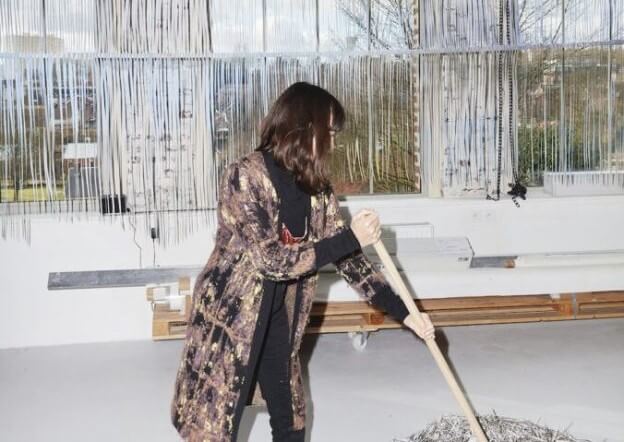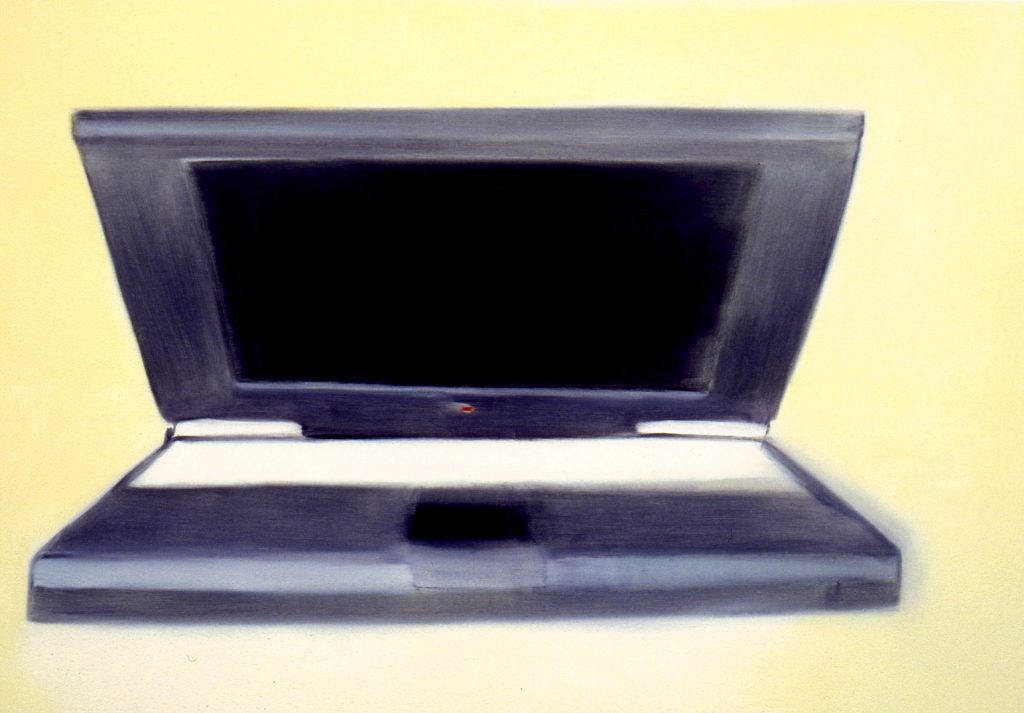FRONTRUNNER Meets Alastair Mackinven

When I first saw Alastair Mackinven’s work, I had no idea that it would, eventually, lead to a nearly two-hour discussion crossing topics such as colour theory, music theory…and Jerry Lee Lewis. As a visual artist, Mackinven is fairly clear on his objectives and what he is not aiming for in building his work. His appreciation for non-narrative, negative spaces are translated in real-time onto his canvases, free from the constraints of digestible rhetoric or concrete description.
Born in Clatterbridge, UK in 1971, he received his BA (Fine Art) from the Alberta College of Art, Calgary (Canada) in 1994 and his MFA (Fine Art) from Goldsmiths in 1996. He then passed through the crucible of rock music in his youth as a guitarist for Scottish art-punk band Country Teasers. He is a part-time lecturer at the Slade School of Fine Art (University College London) and shows with Maureen Paley (London) and Reena Spaulings Fine Art (New York/Los Angeles). His work has been shown at international venues including the Museum of Fine Arts, Houston (Texas), the State Hermitage Museum (St. Petersburg), and the ICA (London).
FRONTRUNNER presents our Summer 2020 Cover Feature: an intense, illuminating discussion with Alastair Mackinven during the COVID-19 lockdown, and how his approach and aesthetic are, truly, forward-facing in the midst of dreary reality/familiarity.

Untitled (2013-17)
Oil and iron powder on canvas
220 x 320 cm
Courtesy of the artist and Reena Spaulings Fine Art (New York/Los Angeles)
Photo credit: Joerg Lohse
What I’ve seen from your works on the walls at Maureen Paley, you seem to have an interest in film, is that right?
Well, no! I have an interest in making art. If you look at what I do through searching my name via Google, you’re going to get a myriad of different points in time that compress together as a jumble. Over the years, my work has taken different forms. There was a point when I stepped away from making film, [or] photography, and I decided that my focus would be entirely on painting. This dedicated commitment to painting followed on from a methodological shift in thinking about making art. I neurologically reprogrammed myself in how I work; dealing with the legacy of my education, which was at Goldsmiths, where I learnt a Neo-Conceptual dogma that I became somewhat disillusioned with over the course of the years. So when you look at certain historic works, which are still important to me, they look removed from the paintings I have made over the past six years. I can’t imagine making another film, even though I understand how to do it, there’s something in painting that is far more active an art form for me.
The current suite of works, the paintings you have within the locus of your practice, how would you characterise those?
I suppose everything is moving away from something, so to characterise a painting in and of itself would be a fiction. I was full of a disillusionment with art that flowed outward to a space of discourse, an affirmative way of making. Art that is built around a network of thought, a contemplation of ideas, then the work is executed, the artist is like a mechanic and the work acts as a bridge that heads back to the embedded discourse. I suppose this is some…methodology through which I was educated. Then there was a point that I found a redundancy within that network, which was brought about by certain experiences. I had all these thoughts going through my head at the same time as the gallery I was working with at that point was imploding, so I had space and time to think about what I wanted to do, what I want art to be, how art should operate and how art is operating right now. It has been a long route to where the work is now, certain experiences were formative in making it what it is. I came to the conclusion that ideas in art are totally useless, I felt and still feel they’re totally redundant. It is a process of codification/de-codification that leads to a value exchange.
It’s a visceral experience of looking at these intensively washed colour fields, almost hovering over the primary range in terms of the colour values. I’m also fascinated by your choice of using iron powder as a medium, and how it resurrected these type of colours that have been lost for so long in the visual lexicon.
Yes. The iron powder is something abnormal, it stands out because of that. I prepare the canvas in a traditional way. I prime it, then ground it with an iron powder. I lay it on the floor, I put a medium on it, then dust the iron powder on the canvas, spray it with a weak acid-like vinegar, it oxidises and turns into a layer of rust, an oxidised iron surface. It’s a warm colour, very porous, very dry, and a slow-moving surface. Because it’s porous, it’s textured. You can sink paint into different spaces, deep in the back, or have it sit on the very surfaces. It enables me to put colour on top of colour. The rusted surface enables the colour to operate as it does, but initially using the iron powder was trying to finding an escape from what I was talking about before. I knew I did not want to work as I had been, but I needed some kind of link from my old way of thinking to help aid me to find a new way. I came up with a syllogism that was, ‘painting is old, old things are rusty, therefore painting is rusty’. Accidentally the material properties of working on a rusted surface enabled me to find a way of painting (which took five years to develop) following the peculiarities of the surface enabled me to find a way forward where I didn’t need to know what I was going to paint, I just learnt how I painted. I would stand there and put paint on and take paint off. That is what painters do!
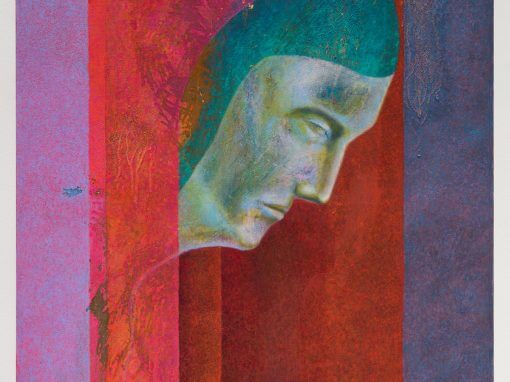
Untitled (2018)
Oil and iron powder on canvas
135 x 100 cm
Courtesy of the artist and Maureen Paley (London)
There does seem to be a thread though, some connective tissue between the imagery and the image quality in the work. There are figures (it’s treading the line of being semi-figurative) and you’re still experimenting with spatial fields and negative space. When I look at it, it’s a sort of backward return to these primordial, humane forms and primordial colour fields, colours that existed before we knew how to see colour.
Yes, there are threads. I recognise that they look like my paintings, there is a kind of unity that occurs in the making of the paintings. Yes they are figurative, and yes the colours are vibrating, it causes a phenomenological response in people or that’s how I respond to them. I suppose this is where I fall into a vagueness, because the making of a painting isn’t affirmative, it’s more of a negative construction than an affirmative attributing of an image to a surface. Colour happens by putting paint on, putting colour on top of colour. It vibrates when you do certain things with it. When I hear about it, it’s like, “Oh God, this is so embarrassing to talk about colour.” I used to share a studio with a painter who used all the colours, he had every tube! He had blue and green, he would mix them together to make new colours. I would tease him, I would go, “Haha, you’re a colourist”, as a way of mocking him. Now I use colours in a way that make people go, “Oh wow, that’s weird”, or, “I’m aware of your colours.” They’re always brought up in reference to beauty, they have a glow or that the colour hovers. These types of statements are said, which I’m aware of, and it’s partly because of the grounding of the canvas.
I’m also thinking when I paint that there are multiple surfaces that exist at the same time within a painting, and I’m not affirming one of them over the others. I don’t see painting as the placing an image on a canvas. This isn’t painting. Painting is a deep space. It’s a process of starting that is followed by a negation of what was just put down as a way to find something that wasn’t anticipated. But each step in the making of the painting, that which at one point existed as surface, which was painted over, is still part of the painting, essential to the process of finding what will there be on the canvas when you sign it off and say, “This is finished.” One of the truths in painting – truths is probably the wrong word – specific to painting, pentimento is specific to painting. You don’t have true extraction in painting you can’t fully erase what’s underneath.
I had an instant narrative. The work was associative, for me, to a book that I read as a child called The Golem: A Jewish Legend by Beverly Brodsky. It’s Jewish folklore. The colours and the figuration, even if it wasn’t made with intention or it wasn’t devised in that way, still triggered this recollection in my memory. Do people come up to you saying responses in that way?
Yes people respond in that way, it depends on the openness of the audience. Certain people try to track it, to terrestrialise it, find a locator, say to me, “Oh yeah, I can see this comes from this, this is from this,” or people have shared an associative memory. This is totally fine, in a way it’s positive. Something very formative and constructive to the way I think about art came from thinking about William Blake. I used to hate William Blake’s art, I found it awful. I was impossible to look at – these figures floating around, so stylised, I just couldn’t get past it, you know, Lord of the Rings, fantasy art, I just couldn’t get into it. But I love the work of the adolescent, the teenager. Most painters love the baby but that’s too loose for me. I like the adolescent, when they have a notion of art, they have some misunderstanding of what it is, and it revolves around a highly rendered form representation. It’s a claustrophobic feedback loop of the attempt to do something as good as they can, without the ability to do it. It’s at the edge of the fingernails, just beyond the ability to make it as it is desired to look but you can feel the focus, and that causes a claustrophobia that I love. It’s so powerful, it rides above art. You get lost in that feedback loop.
I had this drawing by a teenager of Blake’s Ancient of Days that I would look at in the studio because it possessed all the qualities I described but incidentally it caused me to think about Blake. How his work was built on myths such as classical Greek mythology, the Bible, Shakespeare, Milton then all of a sudden he puts atop of all of these known stories his own tales. Pure brutal invention but you could still connect to it and feel these invented stories. I realised I was wrong, Blake was a true genius! This led me to think about Levi Strauss’s Mytheme and how the thread of myths was similar between cultures that would have had no contact with each other. If this was the case then it must be possible to turn off thought and still tap into that universality that could generate an empathetic reaction in people.

Photo courtesy of the artist
I have to be completely frank, I’m becoming emotional when you talk about this. The Golem, the book I was referring to earlier, is a book that I stole from my synagogue’s library as a child. The man-made “superman” that eventually crumbled because he destroyed versus created. The Golem was never meant to build anything – it obeyed and then destroyed. Everything you said about the story being there, it was immediately present for me, even now. That story was so potent for me, on reflecting the utter fragility and helplessness of humanity to have to resort to making a monster.
Absolutely, and this is repeated again and again, many stories have this charge to them, this paradox.
For me, having seen that book by Brodsky, this ancient Jewish legend – when I walked into the space, the colour values were immediately evocative. But it was really that invisible narrative, the one that you don’t construct knowingly, the one that’s there, the one that’s present and that’s probably been present through Blake. So it goes back to exactly what you’re saying about teasing the narrative out, and not even laying a finger on it.
Yes, it’s like an acceptance of an understanding of a structure, how something can work, instead of wanting to provide the visual depiction of it. If I was to paint the story of the Golem, all it does is lead you away from the painting, lead you to the story, the idea, the folklore. The painting is ultimately a bridge or a stepchild to the story, whereas if I embrace not knowing what I’m doing, and move away from something that is not right until I do something – ultimately it is gross, quite frankly do I want to be making these paintings? It’s embarrassing. I’m a middle-aged man, it’s like when a middle-aged painter turns to making paintings about the myth, it’s ultimately embarrassing. When you speak to a painter or another artist about art, it’s a vague language used, it’s very much trying to grasp at the impossible things to say. It’s got a beauty to it. When you can understand someone, despite the pathetic language they have to use to try and describe the desires they have or what they recognise within their work.
You teach now, correct?
Yes I’ve been teaching at the Slade for the past eight years. I also have spent five to six years visiting Peter Doig’s class at Düsseldorf Academy.
I’m curious about how you discovered your own discourse, the way you talk about your practice: could you chart that shift before you became an educator?
There is a conflicted way that I speak about art – even though when I paint, I am not embedding it in the work. I can step back and objectively understand it. At one point, I speak like someone who went to Goldsmiths in the ‘90s (in terms of an understanding of my work), but I operate as someone who understands that the embedding of critique is not by having it highlighted as the main subject of the painting. I connect this paradoxical situation to what Barnett Newman said, that the artist’s role is that of ornithologist and bird. I relate to that when I’m in the gallery and the paintings are there. Ultimately I just want to stand next to them and be quiet and dribble, because what can I actually add to it? Also being wrapped up in the problems of this, because that is pulling you back into modernist myth of the artist. This is both the problem and the object of the making, it is always present, so it’s a dialectical operation. And that’s how the paintings can exist today, within this dialectical struggle that exists within the making of them. Just like, “Yeah, I know that I can’t do that,” a refusal of the thing with which you are fully aware of, and the critique of that keeps the work vibrating, operational, problematic. My main fear when I first started showing these paintings was I would get lumped into this hyper-subjectivity painting world, where it’s all about the artist, which I see as a total dead end. The awareness is essential to allow the painting to have life to it, it’s an assertion of a position at this point in time: which is that I’m not going to be a fucking gestural painter. I’m not going be gestural, I’m not going to be discursive, I’m not going to provide you with answers, but I know that this is how it works.
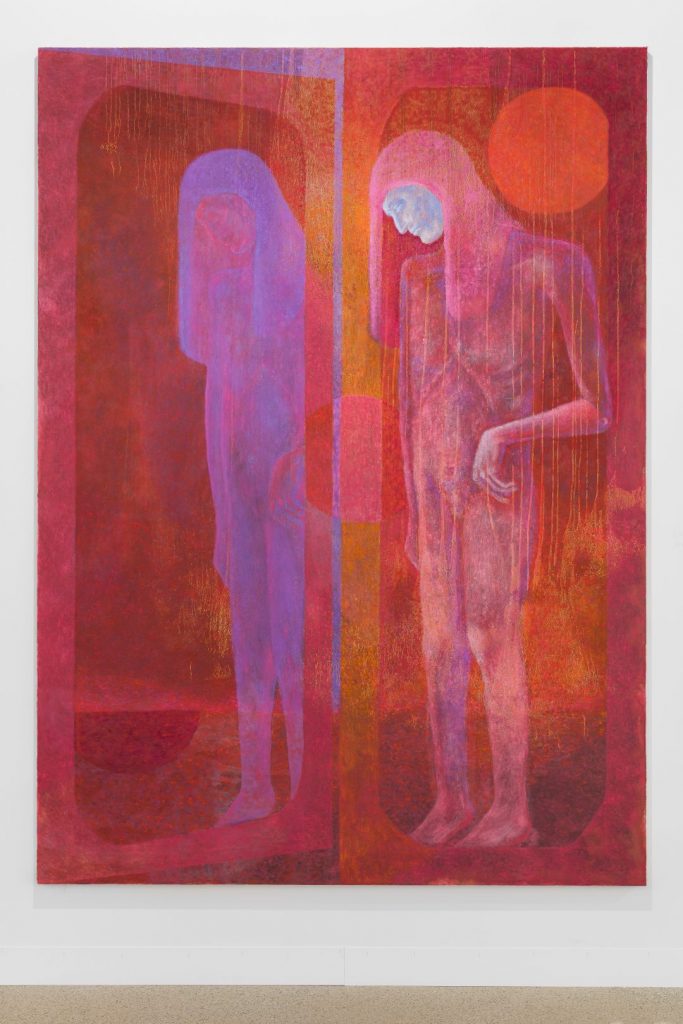
Untitled (2018)
Oil and iron powder on canvas
220 x 160 cm
Courtesy of the artist and Reena Spaulings Fine Art, Inc. (New York/Los Angeles)
Photo credit: Joerg Lohse
It does beg the question, because the next frontier is approaching the commercial/capitalist gallery where you deal with the monetisation of the work, carrying a very “ink on paper value”. How did that process come about monetising and commercialising the work? What is your relationship to it now?
It’s present in ways that people don’t necessarily recognise. It’s within decisions that are made by me as an artist in choosing which gallery to work with; usually if one gallery is interested in working with you there are more interested, so there is a choice to who you work with. What you notice about Reena and with Maureen, is it is about the shows in the gallery, the rooms are not massive. The room accommodates a working method that doesn’t place pressure on the artist to industrialise what they do.
Many galleries do this by having five locations, 10,000 square feet each, rooms the size of museum spaces, only a specific form of production can work in these settings. Working with Maureen and Reena initially states that I am aware of this capital that the art possesses, I am not willing to industrialise myself because I couldn’t make a painting like I do to fill so many walls. I labour on them for months, if not years. It is similar in music, in the 1950s they had the 7-inch single, you know, one song per side. You could be the greatest band in the world, making the perfect single, two songs, and then it expands to the album, they’ve got to make 30 minutes worth of music. Then in the ‘60s, you had to do your master work, your magnum opus, a double album, it’s an hour’s worth of music. Then the CD arrives, and it’s up to 74 minutes. Now you can make indefinite amounts held within streaming sites. So the pressure on the musician or the artist is to scale up to the goldfish bowl.
Aside from quarantine – being a sort of cultural push – everyone’s attention spans have both inflated and deflated within a matter of weeks at a time, where we could sit and listen to a Brahms concerto for hours and feel like, “Great. Great way to pass the time.” And now, this obsession with four-minute gifs and vines and little bitty bites of information, because we’re so over-saturated.
I’m talking from is the position of the maker, and Brahms would probably spend a year or two on a symphony or a concerto. Whereas, the other side of things is how to do that tiny little chunk, those few bits of information. I suppose as a consumer, I’m constantly aware of my addiction to that and the distraction of it, it reminds me of being a smoker. I’m not anymore, but it reminds me of the satisfaction followed by a wave of deflation and the feeling of wasting time. So scroll some more: it’s like training a mouse to seeing how hard it will work for sugar or cocaine.
Speaking earlier of the A-side, B-side, it reminded me of you mentioning music theory. So you possess an interest in it. Where did music theory come from for you?
I played in a cult band as a guitarist, we were called Country Teasers, we recorded, and toured a lot in the late ‘90s early 2000s. The last record was 2006, it was a musician named Ben Wallers’s band and I played guitar for him. It was this great experience! We still collaborate on music – we put out a triple album as the Stallion in 2017. But when I was young, I thought, “Oh God, am I interested in learning these things? Am I interested in what the notes are called and what key this is in?” But when we were doing the recent album, because it was basically a cover album, I had to learn these songs so we could detour away from them and have them turn into their own thing. I had to learn all these things, as it was a more demanding endeavor. It forced me to learn, which was interesting.
Then, a month before my first solo exhibition in New York in 2017, I was diagnosed with cancer.
My surgeon said, “Don’t go, this is a ridiculous idea, we need to operate now!” but I was thinking, “Well, this will be truly devastating if I don’t do this show, so I’m going to go and I’ll start treatment when I am back.” I had major surgery, which knocked me out for three months, which was followed by chemotherapy for seven months. People idealise recovery imagining you can binge watch box sets, you can engage your inner lazy person and just enjoy magazines and looking guilt-free at Instagram. But the truth is that when you’ve gone through such a severe operation and you’ve been pumped full of extreme chemicals, you can’t even look at an image. You can’t look at a phone, you can’t write an email, you can’t engage in conversation, I couldn’t engage with anything. It was all too much. The only thing I found solace in was playing scales on my guitar. I would sit there and play scales all day – because you don’t need to look, you can figure it out by feel, it’s repetitive, it loops and you move from here to here on the fret board, it is a pattern. It released me from how I felt, I could keep my brain active and do something repetitive, and find an escape from the surgery and the chemotherapy, which was very tough. Since then, it has opened up a door, a fascination with music theory, even though I’m slowly going through it on my own and I’m probably misunderstanding it. But it’s a problem, an abstraction like mathematics or art, it occupies my mind.
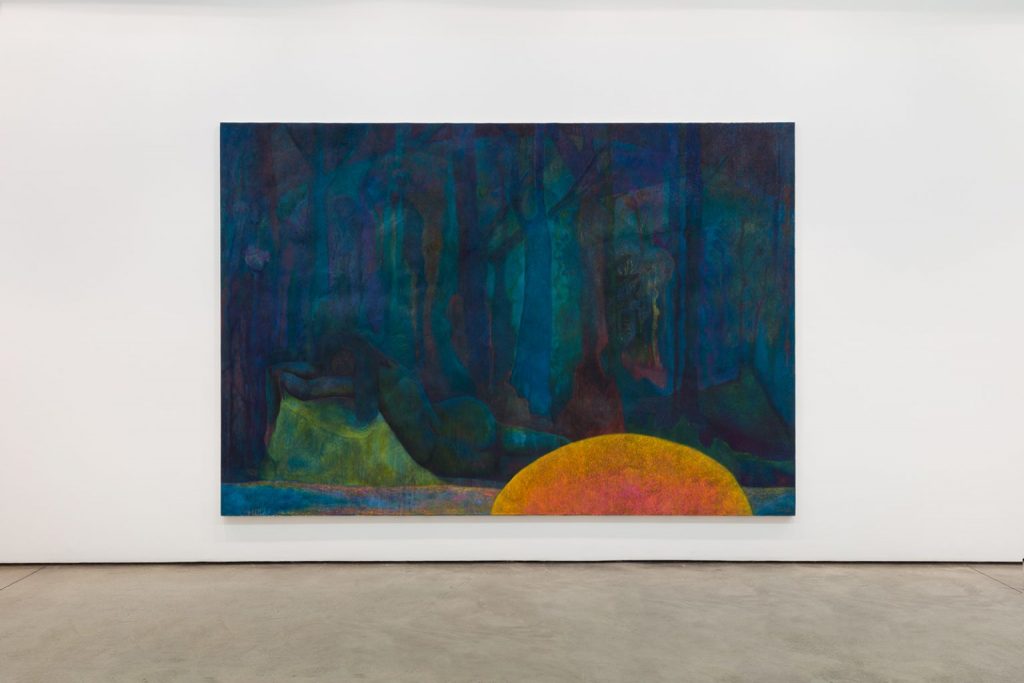
Untitled (2015-18)
Oil and iron powder on canvas
220 x 320 cm
Courtesy of the artist and Maureen Paley (London)
When you talked about old 45s and vinyl’s…my father, even to this day, does not listen to anything created beyond 1963. I grew up on Richie Valens, Elvis, Fats Domino, that was my musical education as a child. Then I was wrenched away into Brahms, Bach, Hanon and Beethoven. I almost played nothing else for at least the 15 years that I was with my teacher, and it drove my father insane. He was like, “Where’s my Fats Domino? Where’s my Little Richard, where’s my Jerry Lee Lewis?” All he heard were these dreary classical music sonatas, and he wanted to break the piano. My teacher was like, “How do you expect her to play Jerry Lee Lewis if she doesn’t play Bach?” My dad’s like, “That’s ridiculous.” Like, are you kidding!? Jerry Lee Lewis was a prodigy, and he was able to adapt, he was able to morph Bach and Beethoven into “Great Balls of Fire.”
Yes, they were very good with harmony and melody, even within a simple structure it is hard to find the unique melody. Like I said, I worked with a musician, I was a guitar player. I can accompany. But to make, I find it difficult to write music, more so than making art, even though I have on occasion done it by applying methodologies that I’ve learned through painting. But it feels like a time thing, it’s too much of a commitment of time to write music as well as paint.
Last question: if you were approached (and as an educator you know this well) by someone who you’ve never met who was just emerging from their BFA, their university, or their MFA program, what is something that you would want them to know?
Most people end up studying art due to a process of educational marginalisation. They don’t really know what art is – like I talked about the adolescent and their misregistration. So, most people enter into it without knowing what it is! Traditional education that prioritises reading, writing, and arithmetic, it doesn’t mesh with everybody, like myself. I am seriously dyslexic, suffered all kinds of learning problems, I hated school, it was a traumatic experience.
I feel that art is this thing that the young person enters into not registering that there is a kind of mechanism of market that surrounds it. Now, of course, kids are savvy because they can kind of see everything on Contemporary Art Daily, they learn this quickly. That is my starting point: art is a pursuit that is self-motivated long before you know of the art world. The longer you work in art the clearer the structure is. A young artist is delicious to the market because they’re unknown, they are potential energy, you can invest [in] easily. Usually there’s an initial bounce, followed by an abandonment because the steep upward market trajectory hasn’t continued. So like everything, beauty fades, fame disappears, success turns into a struggle.
My advice is that the studio is sovereign. It is all about making the work, you’re engaged making the work, and making it how it must be. When the work leaves the studio, after the hang, then it is gone. It is out of your control, there’s nothing you can do, everything you can do has already been done, it leaves your hands so quickly. You can stress about it, you can try to go to the right parties, try to be in the network, try to shake the right hands, but ultimately, the work needs to be the thing that withstands you. This can only happen by spending time at the studio and caring about the thing that you do, caring about your subject, knowing your history and actually just being enraptured by the idea of making art. Good art requires the viewer to overcome their prejudices and assumptions about what art is, so that allows you an autonomy within the making of art, make something that someone has to overcome themselves to engage with.
In other words, be like Jerry Lee Lewis.
Yeah, absolutely, Jerry Lee Lewis. I find it interesting that he was a man of God who knew that he was making “The Devil’s music.” Knowing that he can do this thing, a dialectical entity. Shit, he doesn’t want to be doing this, he wants to be playing sacred music, he wants to be playing gospel. That gives his music its friction, not because of him subjectively wanting to work the kids up into a frenzy. He’s fighting with the drive to do something that in his mind is forbidden, but it comes out of him, but he knows the other side, the sacred. Ultimately, I relate, in truth I would like to be Wade Guyton. I’d like to be making cool black paintings.
This interview with Alastair Mackinven appears as the Cover Feature of our Summer 2020 Issue.






